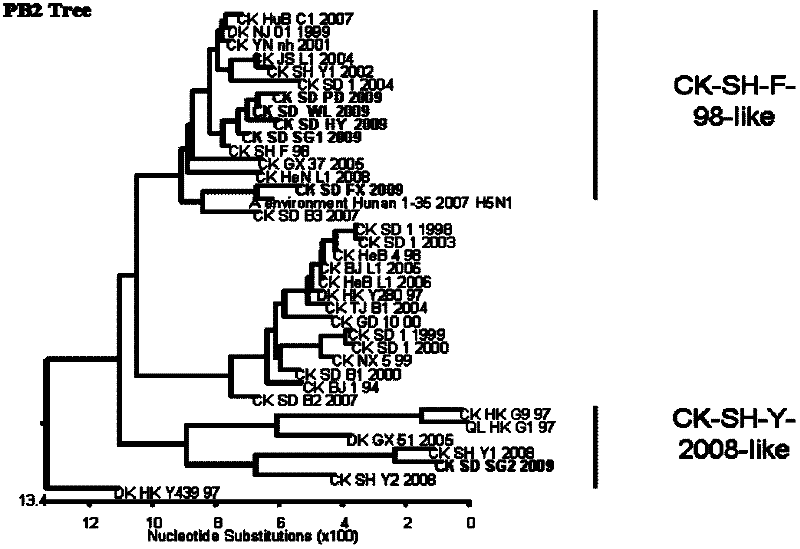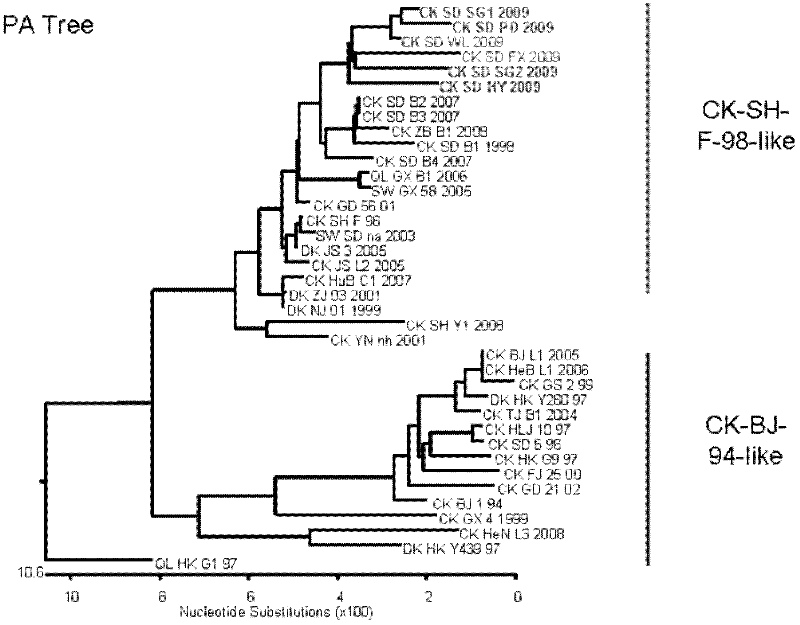H9N2 avian influenza virus vaccine strain and application of H9N2 avian influenza virus vaccine strain in immune protection
A technology of avian influenza virus and vaccine strains, applied in the field of animal virology, can solve problems such as chickens prone to secondary respiratory diseases, immune suppression, and affecting poultry production performance
- Summary
- Abstract
- Description
- Claims
- Application Information
AI Technical Summary
Problems solved by technology
Method used
Image
Examples
Embodiment 1
[0038]A H9N2 avian influenza virus vaccine strain, that is, a recombinant chicken-derived H9N2 avian influenza virus strain A / Chicken / Shangong / SG2 / 2009, the isolation and identification methods of the virus are as follows:
[0039] 1. Treatment of disease materials and inoculation of chicken embryo allantoic cavity
[0040] Aseptically grind the collected disease materials, collect the extract, or repeatedly freeze the nasopharyngeal or tracheal swabs in normal saline for 3 times, then centrifuge at low speed, collect the supernatant, and collect the supernatant in the SPF chicken embryos aged 9 to 11 days. Inoculate 0.2ML of virus fluid into the allantoic cavity of the human body, incubate at 35°C-37°C, collect the allantoic fluid of chicken embryos that died naturally or did not die within 24-72 hours, use hemagglutination inhibition and PCR methods to identify virus subtypes, and PCR to identify primers See Table 1-1; in the process of continuous passage, select the virus l...
Embodiment 2
[0061] experimental method:
[0062] 1. Preparation of H9 single-factor serum
[0063] 6 strains of H9N2 subtype AIV isolated in 2009 (including the vaccine backup strain A / Chicken / Shangong / SG2 / 2009 clearly involved in this paper), and 5 strains of H9 subtype avian influenza virus isolated before 2008, a total of 11 viruses , to prepare oil emulsion inactivated vaccines respectively. The 4-week-old SPF chickens were immunized with the above vaccines, raised in an isolated feeder to prepare single-factor serum, and immunized twice with an interval of 2 weeks. Blood was collected 14 days after the second immunization, and positive serum was prepared respectively.
[0064] 2. Crossover HI test
[0065] 11 strains of viruses were used as antigens, and 4 units of viruses were prepared respectively, and cross-HI tests were performed with 11 single-factor sera to detect the reactivity of the HA antigens of these H9N2 viruses. The experiment was repeated three times, and the averag...
Embodiment 3
[0081] 1. Vaccine Preparation and Immune Challenge
[0082] In order to determine the immunogenicity and vaccine protection effect of the vaccine strain virus, an oil emulsion inactivated vaccine was prepared, and 20 3-week-old SPF chickens were immunized. At the same time, 6 SPF chickens were immunized with PBS as a blank control. Serum was collected three weeks after immunization and tested. HI antibody levels to the virus. Immunization chicken is divided into two groups, every group 10, and I group carries out challenge virus (intravenous injection) with vaccine virus A / Chicken / Shangong / SG2 / 2009 (H9N2) (CK / SD / SG2 / 2009 for short) of the present invention , Group II was challenged with A / Chicken / Henan / L3 / 2008 (H9N2) (CK / HN / L3 / 2008 for short), and the dose was 100ul, (100ul contained 10 5 EID 50 ). Three and five days after the challenge, the throat cotton and cloacal cotton were collected from each chicken in the test group and the control group, and immediately placed in ...
PUM
 Login to View More
Login to View More Abstract
Description
Claims
Application Information
 Login to View More
Login to View More - R&D
- Intellectual Property
- Life Sciences
- Materials
- Tech Scout
- Unparalleled Data Quality
- Higher Quality Content
- 60% Fewer Hallucinations
Browse by: Latest US Patents, China's latest patents, Technical Efficacy Thesaurus, Application Domain, Technology Topic, Popular Technical Reports.
© 2025 PatSnap. All rights reserved.Legal|Privacy policy|Modern Slavery Act Transparency Statement|Sitemap|About US| Contact US: help@patsnap.com



